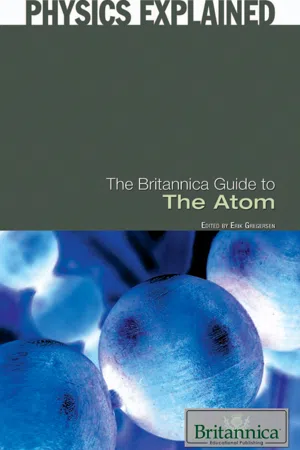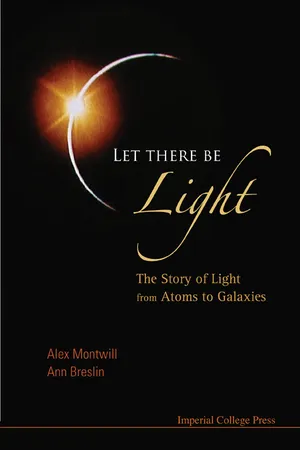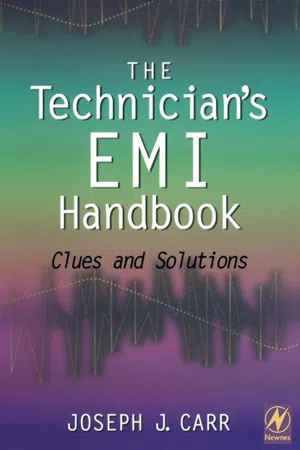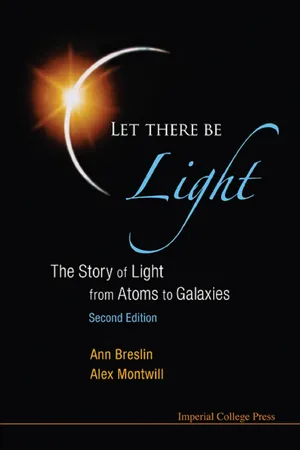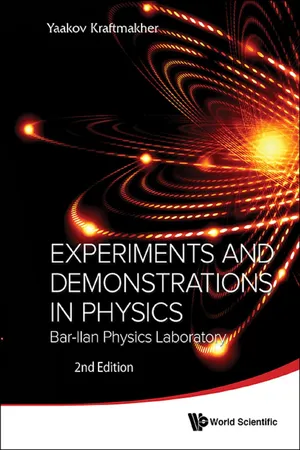Physics
Millikan's Experiment
Millikan's Experiment, conducted by Robert A. Millikan in 1909, determined the elementary electric charge (the charge of a single electron) with high precision. The experiment involved measuring the force on tiny oil droplets suspended in an electric field, allowing for the calculation of the charge of each droplet. This groundbreaking work provided crucial evidence for the quantization of electric charge.
Written by Perlego with AI-assistance
Related key terms
Related key terms
1 of 4
Related key terms
1 of 3
9 Key excerpts on "Millikan's Experiment"
- eBook - ePub
- Ronald L. Numbers, Kostas Kampourakis, Ronald L. Numbers, Kostas Kampourakis(Authors)
- 2015(Publication Date)
- Harvard University Press(Publisher)
Ideas explicitly expressed in Einstein’s, Planck’s, and Bohr’s original papers are “tampered with” in order to fit into the textbook culture of pedagogical expediency. The works of Einstein, Planck, and Bohr are presented as being motivated by their wish to explain experimental results that had been either unaccounted for or explained in an unsatisfactory manner. In textbook accounts, Einstein appears dissatisfied with the Lorentz-Fitzgerald explanation of the M-M experiment; Planck not satisfied with the lack of explanation for the Wien and the Rayleigh-Jeans laws; and Bohr not content with the hitherto unexplained Paschen-Balmer series. It appears that textbooks have followed a coherent historiographical viewpoint, which, while differing in its details, has an incredibly strong grip on both writers and readers: the heroes of modern physics are those who provided ingenious explanations of recalcitrant experimental results.Passage contains an image
MYTH 19THAT THE MILLIKAN OIL-DROP EXPERIMENT WAS SIMPLE AND STRAIGHTFORWARDMansoor NiazBy a brilliant method of investigation and by extraordinarily exact experimental technique Millikan reached his goal. —Allvar Gullstrand, Presentation speech to award Nobel Prize to Robert A. Millikan (1924)[The] Millikan oil-drop experiment [was the] first direct and compelling measurement of the electric charge of a single electron. It was performed originally in 1909 by the American physicist Robert A. Millikan, who devised a straightforward method of measuring the minute electric charge that is present on many of the droplets in an oil mist.… Through repeated application of this method, the values of the electric charge on individual oil drops are always whole-number multiples of a lowest value—that value being the elementary electric charge itself (about 1.602 × 10−19 coulomb). From the time of Millikan’s original experiment, this method offered convincing proof that electric charge exists in basic natural units.—“Millikan’s Oil-Drop Experiment,” Encyclopedia BritannicaWhat is electricity? This seems to be a simple question and may be discussed these days even in a primary-school classroom. The manifestation of electricity can be demonstrated by the movement of a pith ball when brought in contact with a glass rod rubbed with silk. Around 1750, Benjamin Franklin (1706–1790) was perhaps the first to suggest the concept of electrical particles or atoms. In 1881, George Johnstone Stoney (1826–1911) first made an estimate of the ultimate electrical unit and named it the electron. - eBook - ePub
- Dmitry Biryukov, Denis Gerasimov, Eugeny Yurin(Authors)
- 2022(Publication Date)
- CRC Press(Publisher)
As usual, poor understanding of the phenomenon does not prevent us from using it in our life. The most famous example is the photocopying Xerox devices; we dwell on a more scientific case— the discovery of the finite electron charge in the Millikan experiments. This experimental setup is now almost a staple of an educational physical laboratory, so we discuss it slightly thoroughly.The scheme of such experiments is shown in Figure 8.1.1 . The method, in its rough explanation, is to measure the electric field strength that is required to hold a charged droplet in place: two forces act on the droplet—gravity mg and the electrical force qE; at equilibrium, we may find the charge of the particle from here:q =(8.1.1).m gEMillikan established that the charge q quantizes—its value is Ne, where e is the elementary charge, N is an integer number that shows how many elementary charges are located on the droplet.From a more accurate theoretical background, some corrections to the relation (8.1.1) have been made; these are not crucial for our purposes. Another question is more interesting: from which source do those electrons appear? The experiment goes as follows: we spray a liquid (an oil) into the gap, apply the electric field from the electric power source, regulating E to obtain its value corresponding to equilibrium, until the droplet is suspended in a gas, and then look carefully inside the gap with microscope, trying to estimate the falling speed of the droplet to determine its size (and, consequently, its mass), when the electric power supply is off.Usually, the size of the droplet (the droplet that can be suspended, other ones would leave a gap) is less than 1 μm, which corresponds to the mass of about ~ 10−15 kg. If a droplet has only a single elementary charge in it, then the electric field applied to the plates is ~ 105 V/m—this is a rather small electric filed; it corresponds to the voltage of ~ 102 V applied to the gap of ~ 1 mm This field is far below the critical values of electric field strength to provoke an electrical discharge here—of orders of ~ 106-2 V/m. This means that free electrons cannot be formed in the gas,1 - eBook - ePub
- Britannica Educational Publishing, Erik Gregersen(Authors)
- 2010(Publication Date)
- Britannica Educational Publishing(Publisher)
In Millikan’s subsequent experiment, he produced the first direct and compelling measurement of the electric charge of a single electron by measuring the minute electric charge that is present on many of the droplets in an oil mist. The force on any electric charge in an electric field is equal to the product of the charge and the electric field. Millikan was able to measure both the amount of electric force and magnitude of electric field on the tiny charge of an isolated oil droplet and from the data determine the magnitude of the charge itself.Millikan’s original experiment or any modified version, such as the following, is called the oil-drop experiment. A closed chamber with transparent sides is fitted with two parallel metal plates, which acquire a positive or negative charge when an electric current is applied. At the start of the experiment, an atomizer sprays a fine mist of oil droplets into the upper portion of the chamber. Under the influence of gravity and air resistance, some of the oil droplets fall through a small hole cut in the top metal plate. When the space between the metal plates is ionized by radiation (e.g., X-rays), electrons from the air attach themselves to the falling oil droplets, causing them to acquire a negative charge. A light source, set at right angles to a viewing microscope, illuminates the oil droplets and makes them appear as bright stars while they fall. The mass of a single charged droplet can be calculated by observing how fast it falls. By adjusting the potential difference, or voltage, between the metal plates, the speed of the droplet’s motion can be increased or decreased. When the amount of upward electric force equals the known downward gravitational force, the charged droplet remains stationary. The amount of voltage needed to suspend a droplet is used along with its mass to determine the overall electric charge on the droplet. Through repeated application of this method, the values of the electric charge on individual oil drops are always whole-number multiples of a lowest value—that value being the elementary electric charge itself (about 1.602 × 10−19 - eBook - ePub
On Fact and Fraud
Cautionary Tales from the Front Lines of Science
- David Goodstein(Author)
- 2010(Publication Date)
- Princeton University Press(Publisher)
These cloud chamber experiments were the starting point of Millikan’s efforts. Working with one of his University of Chicago graduate students, Louis Begeman, he had the idea of applying a much stronger electric field than any used previously. His reasoning was that this would completely halt the falling cloud, allowing him to make a much more precise measurement of the charge on its droplets. To his surprise, when he trained a laboratory telescope (not to be confused with an astronomical instrument) on the cloud in order to observe the drops, he found that applying a powerful field had not stopped the cloud’s descent. Instead, nearly all of the ionized droplets dispersed upward or downward, leaving in view just those few droplets whose electric force came sufficiently close to balancing the effect of gravity to temporarily immobilize them. Millikan quickly realized that measuring the charge on individual ionized droplets was a method far superior to finding the charges on droplets in a cloud.It may have been during this period that Millikan’s wife, Greta, attending a social event while Millikan spent one of his many long evenings in the lab, was asked where Robert was. “Oh,” she answered, “He’s probably gone to watch an ion.” “Well,” one of the faculty wives was later overheard to say, “I know we don’t pay our assistant professors very much, but I didn’t think they had to wash and iron!”3Unfortunately, with water as the medium, the single-droplet method had a serious flaw: The water evaporated too rapidly to allow accurate measurements. Millikan, Begeman, and a new graduate student named Harvey Fletcher decided to try doing the experiment with some substance that evaporated less rapidly, and Millikan assigned to Fletcher the job of devising a way to use mercury or glycerin or oil. Fletcher chose oil and almost immediately got a crude apparatus working, using tiny droplets of watch oil that could be sprayed out of a perfume atomizer he had bought in a drugstore. When he focused his telescope on the suspended oil droplets, he could see them dancing around as they collided with unseen air molecules, in a textbook demonstration of Brownian motion. This itself was a phenomenon of considerable scientific interest.When Fletcher finally persuaded the busy Millikan to look through his telescope at the dancing, suspended droplets of oil, Millikan immediately abandoned all his efforts to pull off the experiment with water and turned his attention to refining the oil-drop method.It took a couple of years, but by around 1910 Fletcher and Millikan had produced two results. The first was an accurate measurement (4.774 × 10-10 electrostatic units) of the unit electric charge (called e ), which they determined from observing how rapidly or how slowly the oil drops rose or fell in gravitational and electric fields. The second result was the determination of Ne - eBook - ePub
Let There Be Light
The Story of Light from Atoms to Galaxies
- Alex Montwill, Ann Breslin(Authors)
- 2008(Publication Date)
- ICP(Publisher)
An electron carries one such fundamental unit of charge, which he measured in his ‘oil drop experiment’ published in 1912. It was natural that he should also turn his attention to a quantitative study of the characteristics of electrons emitted in the photoelectric effect. His first step was to measure the energies of electrons emitted by light of various frequencies shining on different metals. As early as 1908, at the Boston meeting of the American Physical Society, he had announced that he intended to measure the kinetic energy of these electrons by a determination of the stopping potential. This is the adverse electrical potential required to prevent them from reaching a second metallic plate at the end of an evacuated tube. Essentially he would give the electrons an ‘electrical hill’ to climb, and investigate how high this hill must be to completely stop the photoelectric current, for different values of the frequency of the incoming light. At first Millikan was quite sceptical of Einstein's theory, and his original intention was as much to disprove as to confirm the validity of the equation. ‘I scarcely expected that the answer, when it came, would be positive, but the question was very vital, and an answer of some sort had to be found.’ The principles of Millikan's Experiment were quite straightforward, but in practice the work was long and tedious, and it took some years to complete. When his results confirmed Einstein's theory Millikan he was generous in giving due credit to Einstein and admitting that his original scepticism had been unfounded. 13.1.7 Millikan's Experiment Millikan's method was to set up a ‘workshop in vacuo’ by enclosing the photosensitive surface in a highly evacuated quartz tube. Light shining on the surface liberates electrons. By applying an electric field in the right direction the electrons can be continually swept away, forming an electric current - eBook - ePub
The Technician's EMI Handbook
Clues and Solutions
- Joseph Carr(Author)
- 2000(Publication Date)
- Newnes(Publisher)
r , is in the denominator and is squared. Because of this relationship, we know that electrical charges obey the inverse square law. Doubling the distance between charges reduces the force to one-fourth the original force. Similarly, halving the distance results in a force that is four times as large.MILLIKAN’S OIL DROP EXPERIMENT
The basic electronic charge was calculated by American physicist Robert A. Millikan (1868–1953) in his famous “oil drop experiment” conducted between 1909 and 1917. Millikan won the Nobel Prize in physics for this experiment. He created an evacuated chamber into which oil droplets could be sprayed from an atomizer. The friction of the atomizer caused some electrons to be stripped free, while an X-ray source ensured that other electrons would be freed.Millikan arranged a pair of electrodes and a voltage source such that the oil droplets were inside an electrical field. Normally, gravity would force the oil droplets to fall toward the Earth. Counterbalancing the gravitational attraction, however, was the electrical force. By placing the positive side of the electrical source on the upper plate, Millikan could attract the electron charged oil droplets upward. He observed the oil droplets through a microscope, while adjusting the voltage between the plates until the downward force of gravity was exactly matched by the upward force of the electrical field, suspending the droplet, motionless, in the space between the plates. Since both the force of gravity and the electric field strength are known, the electronic charge could be calculated. He noted that the values tended to be integer multiples of 0.16 × 10−18 C (i.e., 0.32, 0.48, etc), and so concluded that the elementary charge is 0.16 × 10−18 , or as it is usually written 1.6 × 10−19 C (later refined to 1.602 × 10−19 C).ELECTRICAL POTENTIAL
Electrical potential refers to the ability to do work, specifically the work of moving electrical charges from one place to another. Potential is created by a difference in the amount of electrical charge at the two points. In Figure 2.6A - eBook - ePub
Let There Be Light
The Story of Light from Atoms to Galaxies
- Ann Breslin, Alex Montwill(Authors)
- 2013(Publication Date)
- ICP(Publisher)
corpuscles) of mass more than a thousand times smaller than the atom of hydrogen. This marked the beginning of Millikan’s interest in the electron.On 10 April 1902, Millikan married Greta Blanchard, a recent graduate of the University of Chicago. The ceremony took place in the evening — in his autobiography he confesses that he spent time until late that day reading the proofs of his book on mechanics in the office of the publishers and almost missed his own wedding! All ended well, however, and the young couple spent the next seven months touring Europe on their honeymoon. They were to have three sons, Clark, Glen and Max.Millikan’s first experiments to determine the charge of the electron were made in 1906, when he built a 10,000 V battery designed to create an electric field strong enough to balance the force of gravity and hold charged water droplets in a vapour cloud suspended in the air. He soon improved the method by using oil drops and watching individual drops through a low power microscope.If the number of electrons carried by the droplet happened to change as an electric charge fell off, or an extra charge was added, the oil drop would suddenly begin to move. By putting each drop through a series of up and down trips by varying the strength of the electric field and timing each trip accurately, Millikan discovered that the speeds of a given drop always changed by a series of steps which were a multiple of a certain unit. This unit change took place, he concluded, when the drop lost or gained a single electron as a passenger.To get the data on one droplet usually took hours, and Mrs Millikan often had to change social arrangements at the last minute, because her husband had been detained ‘watching a drop’. Millikan was so convinced by the experiment that he wrote: ‘One can count the number of free electrons in a given small electrical charge as one can attain in counting the number of one’s fingers or toes.’ He presented his final results on the charge of the electron at the 1912 meeting of German physicists in Berlin, quoting a value of (4.806 ± 0.005) × 1010 electrostatic units (= 1.603 × 10−19 - eBook - ePub
- Max Born(Author)
- 2013(Publication Date)
- Dover Publications(Publisher)
When the field is switched on we find that some drops are not affected by it at all, others fall more rapidly or more slowly than before, and some even rise in defiance of gravity. Now it is easy to measure the charge on a droplet: we may, for example, adjust the field-strength so that the droplet just remains floating in the field of the telescope. Then and if we know the weight from the rate of fall when there is no field, and measure the field-strength, we can find the charge, which is equal toWeight of Droplet = Charge × (Field-strength),This is what Millikan did with a great many particles. He found charges of the most varying sizes, but among these there was a definite minimum charge, the smallest which was ever obtained. All other charges were exact multiples of this minimum charge.The atomic nature of electricity is thus established, and the actual magnitude of the elementary charge (in the usual technical units) found. There is no point in stating the actual number. We must, however, attempt to give an idea of its magnitude by quoting effects which can readily be grasped.If Millikan’s plate apparatus is connected to the house lighting circuit at 200 volts, how great is the force on one electron? That depends on the distance between the plates. If we imagine that the plates are 1 mm. apart, the force is about as great as the weight of one three hundred millionth part of a milligram (3 × 10– 9 mgm.). This seems very-little—but if we choose an appropriate object for comparison, it is really enormously large. We may take the weight of the electron itself. As we know the charge and the ratio we can calculate the mass. We find that the electron weighs about 10 –24 milligrams. The electric force is thus immensely greater, by the factor 3 × 1015 or three thousand billions.Many readers will perhaps have wondered why we have said so little about gravitational forces. For these govern our whole destiny; they enable us to remain sticking to the earth, and they determine the path of the earth in its motion among the heavenly bodies. Must not gravity play an important part in the world of the atom? - eBook - ePub
Experiments and Demonstrations in Physics
Bar-Ilan Physics Laboratory
- Yaakov Kraftmakher(Author)
- 2014(Publication Date)
- WSPC(Publisher)
A. Gullstrand, Chairman of the Nobel Committee for Physics. Presentation of Robert Andrews Millikan awarded the Nobel Prize “for his work on the elementary charge of electricity and on the photoelectric effect” (1923).Many papers were published on this experiment, and only a fraction of them is mentioned here. Hanson and Clotfelter (1966) presented an evaluation of equipment commercially available for determining the h/e ratio in student laboratories. The authors stressed that certain practical problems encountered in this experiment make good results difficult to obtain. In particular, a serious problem is caused by the emission of electrons from the anode. The Leybold’s apparatus includes a vacuum phototube with an anode in the form of a platinum wire loop that can be heated shortly before taking data. The purpose of the heating is to vaporize any material that has condensed on the anode from the photocathode. It turned out that the results obtained strongly depend on this procedure. Hall and Tuttle (1971) used an AC amplifier for measuring the photocurrent caused by an AC-powered mercury arc. Hall (1971) developed an efficient amplifier for AC photoelectric measurements. Carver and Crawford (1975) described a demonstration of the photoelectric threshold. Powell (1978) justified a procedure of determining the stopping potential from a plot of photocurrent root squared versus applied bias voltage. Steinberg et al (1996) developed a computer-based tutorial on the photoelectric effect.Einstein’s famous equation and Millikan’s outstanding experiment. Under normal conditions, free electrons that move inside a metal cannot leave it and escape outwards. This means that a potential barrier exists at the surface of the metal that prevents electrons from leaving it. The energy necessary for an electron to leave the metal at the absolute zero temperature is called the work function
Index pages curate the most relevant extracts from our library of academic textbooks. They’ve been created using an in-house natural language model (NLM), each adding context and meaning to key research topics.
Explore more topic indexes
Explore more topic indexes
1 of 6
Explore more topic indexes
1 of 4


